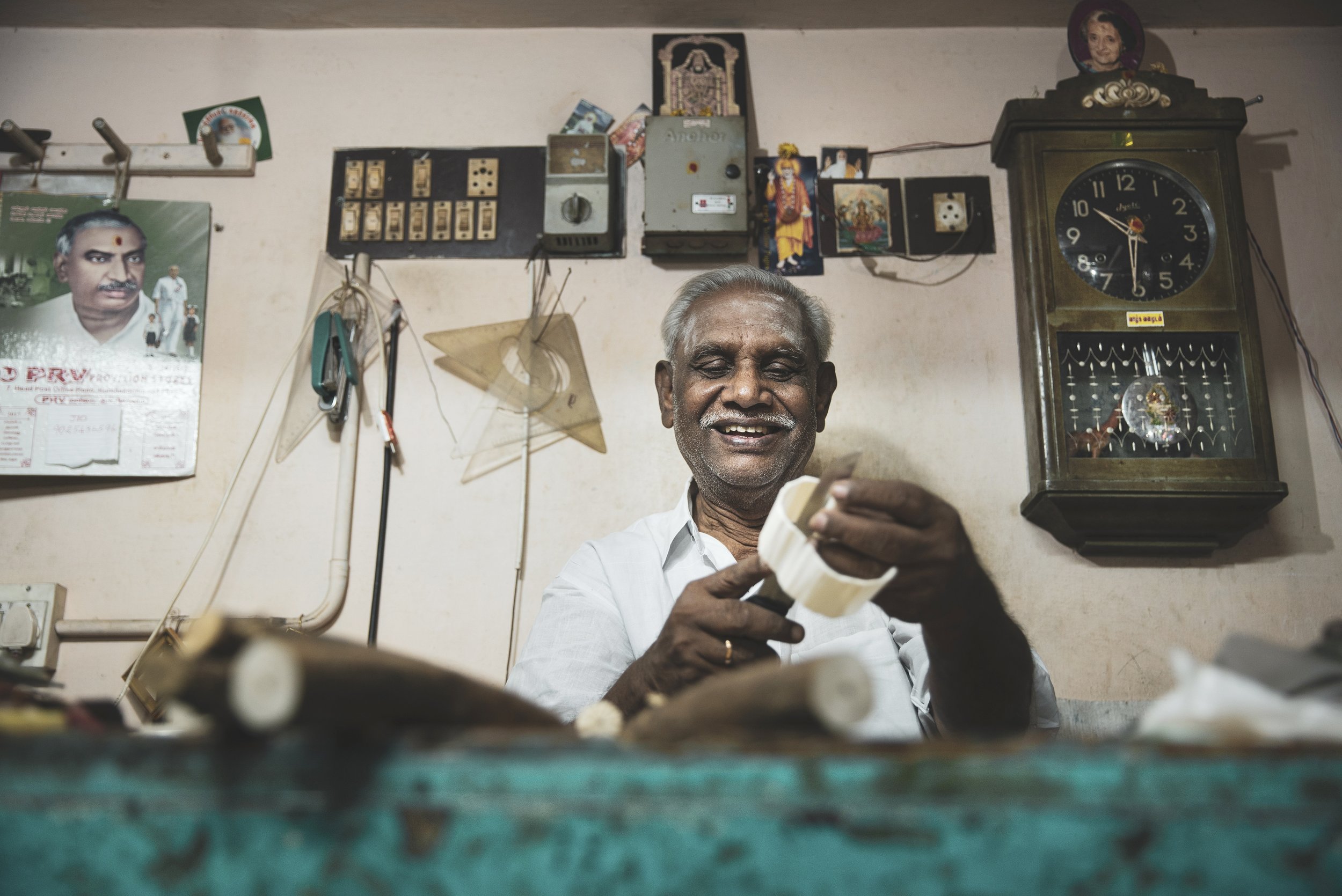The Pithy Craft of Pith Carvings
Words by Aashika Suresh
Captured by Naveen Sekar
Snuggled between a small coffee outlet and a grocery store opposite Kumbakonam’s Head Post Office is a narrow crevice with a bright blue board on top that reads Prakasam Pith Works Handicrafts. This is where you can find Mr K. A. Chokkalingam’s residence cum showroom cum factory. The 75-year-old is Kumbakonam’s oldest living pith craftsman – master craftsman, going by his award and the declaration on his board.
Pith work is an ancient handicraft that uses Indian cork (aeschynomene aspera) to make decorative and religious items. The aquatic plant grows primarily in marshy ponds and wetlands in humid areas – mostly West Bengal, Tamil Nadu and some parts of Andhra Pradesh and Karnataka in India. After drying, and peeling out the outer brown skin, the material’s ivory-like core makes it an ideal resource for elegant collectables. However, its structure is similar to polystyrene (commonly called thermocol), requiring a trained craftsman with deft fingers to create such structures.
In West Bengal, sholapith is an essential part of Hindu festivals, especially the annual Durga Pujo, where elaborate decorations in pandals and idols are carved from it. Down south, small communities in Thanjavur and Kumbakonam struggle to keep the craft alive.
When we arrive at Chokkalingam’s doorstep a little past 9 AM on a Tuesday, we learn that the store does not open for another hour. Yet, when he spots us from his residence on the first floor, waiting for him, Chokkalingam comes down to greet us immediately. There isn’t the slightest hint of annoyance on his face. He is all smiles and pleasantries, even offering us tired city-folk some breakfast.
After a quick struggle with the shutters, he ushers us into his compact showroom. As we look around, noting the different models he has built (Madurai Meenakshi temple and the Thanjavur temple being the most popular ones, he says), thye pride on his face is evident. Over six decades of craftsmanship has gone into establishing the store as it is today.
We examine the glass-cased carvings in awe. Even the smallest structures are meticulously detailed – the dents in the gopurams, the chakra spokes, the little elephant carvings. After we have had our fill of marvelling, we sit down to chat.
Chokkalingam is eager to tell his story. Seating us across himself, he pulls out a thick spiral-bound book from behind a glass case to explain the history of netti, as it is called here and his engagement with it so far.
Explain your craft to us.
This (sholapith) is a water plant. It is similar to the lotus stem and grows mostly in freshwater lakes. We collect the stem of this plant and then we carve on it using knives or other tools. In English, it is called sholapith, but we call it netti.
Earlier, when I was in the Guru Kul system under my guru, we used to gather the netti ourselves. We would go to the ponds in Thiruvarur, Nagapattinam, Mayavaram (Mayiladuthurai), Thiruthuraipoondi. They’re near the delta, so a lot of netti would grow there. Now the ponds and lakes have dried up. We buy filter water to drink. These days, the raw materials come from Andhra Pradesh. (They have the Krishna River.)
How long have you engaged in this? Is it a family profession or was it born out of your interest?
I started learning pith work in 1954 when I was 10 years old. I learnt from my guru, Sri Swami Sivprakasam, and have been doing this since. After he passed away in 1972, I continued the business and even started this showroom under his name – Prakasam Pith Works Handicrafts.
My great grandfathers and ancestors were blacksmiths, working near the collector’s office in Thanjavur. My paternal grandfather, being a little more ambitious, became a chariot maker. My maternal grandfather would make decorations out of netti and other things. My father was a goldsmith while some other relatives were carpenters.
My father died when my mother was pregnant with me. I am the youngest of five children – we are like the five Pandavas. I went to school only till class five. After that, I didn’t have the resources to continue my education. There was no food to eat at home. I had to work. If I would have gone to school, how would I have survived? Initially, I did odd jobs like working as a carpenter or electrician. Then my guru took me in as his disciple and taught me pith craft.
How do you feel when you are engaged in your craft?
The first item I ever made was a flower. After that, I started making larger models. I have made a model that is in Madurai’s Airam Kaal Mandapam. It took me three-four months to make. Even four days ago, I did a flower demonstration. Soon, I will get the patent rights for pith craft. People come to talk about the craft, learn it, and go away. When I do something, I go deep into it. I have learnt the history of it. I feel happy doing this every day.
What do you think about the future of this?
I did not force my children to do this. Why would I? There is no money in this. Tell me, how much did your phone cost? Will I be able to afford 45,000 or 50,000 rupees for a phone? My cell phone costs 2,000 rupees.
They have desires too. I shouldn’t hinder their growth. If this is what they wanted, if the love for this craft had come from within, they would have pursued it. The money would have been enough then – after all, I raised them with income from this craft. They need to have that intent. This generation wants everything fast, which you cannot get with this craft.
I have trained many people – but only two-three of them continue to pursue it. The money in this is meagre. These days, the state and central government take the finished product from us and give us money only after the sales. Can we survive like that? I don’t know how many people will be interested in pursuing this any longer.
What motivates you to create every day?
I am very happy and satisfied to be doing this today. You need to love what you do; it needs to come from within. I am 75 and I still create every day. I can be healthy only if I keep doing this. In the past, my children often asked me to give it up, but I told them no, I cannot ever give it up. This is the reason for their growth. It is my identity. So, they let me do it. Now, all my children support me morally and financially. I do it because I love it.
I took out loan after loan to sustain my craft. I took out a 500 rupees loan in 1975 to establish the shop. I had to struggle for 6 months to get it. I would let a day’s wages go and sit at banks for a loan. Today, I have been sanctioned over 10 lakhs of the loan in total. I don’t have to go to the bank any more. They say they will come and sanction it at my doorstep. That is the kind of credibility I have built for myself. I wanted to build a showroom. I have done it. I have a workshop down below and a house above here. All of this is possible only because of my craft.
You came searching for me. You would have been disappointed if I was not here. That is my responsibility – to do it till the day I die.

